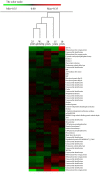Proteomic Analyses Provide Novel Insights into Plant Growth and Ginsenoside Biosynthesis in Forest Cultivated Panax ginseng (F. Ginseng)
- PMID: 26858731
- PMCID: PMC4726751
- DOI: 10.3389/fpls.2016.00001
Proteomic Analyses Provide Novel Insights into Plant Growth and Ginsenoside Biosynthesis in Forest Cultivated Panax ginseng (F. Ginseng)
Abstract
F. Ginseng (Panax ginseng) is planted in the forest to enhance the natural ginseng resources, which have an immense medicinal and economic value. The morphology of the cultivated plants becomes similar to that of wild growing ginseng (W. Ginseng) over the years. So far, there have been no studies highlighting the physiological or functional changes in F. Ginseng and its wild counterparts. In the present study, we used proteomic technologies (2DE and iTRAQ) coupled to mass spectrometry to compare W. Ginseng and F. Ginseng at various growth stages. Hierarchical cluster analysis based on protein abundance revealed that the protein expression profile of 25-year-old F. Ginseng was more like W. Ginseng than less 20-year-old F. Ginseng. We identified 192 differentially expressed protein spots in F. Ginseng. These protein spots increased with increase in growth years of F. Ginseng and were associated with proteins involved in energy metabolism, ginsenosides biosynthesis, and stress response. The mRNA, physiological, and metabolic analysis showed that the external morphology, protein expression profile, and ginsenoside synthesis ability of the F. Ginseng increased just like that of W. Ginseng with the increase in age. Our study represents the first characterization of the proteome of F. Ginseng during development and provides new insights into the metabolism and accumulation of ginsenosides.
Keywords: Panax ginseng; energy metabolism; ginsenosides biosynthesis; growth; proteomic analysis.
Figures









Similar articles
-
Effects of growth years on ginsenoside biosynthesis of wild ginseng and cultivated ginseng.BMC Genomics. 2022 Apr 23;23(1):325. doi: 10.1186/s12864-022-08570-0. BMC Genomics. 2022. PMID: 35461216 Free PMC article.
-
Comparison of the metabolomic and proteomic profiles associated with triterpene and phytosterol accumulation between wild and cultivated ginseng.Plant Physiol Biochem. 2023 Feb;195:288-299. doi: 10.1016/j.plaphy.2023.01.020. Epub 2023 Jan 13. Plant Physiol Biochem. 2023. PMID: 36652850
-
Transcriptomic profiling reveals MEP pathway contributing to ginsenoside biosynthesis in Panax ginseng.BMC Genomics. 2019 May 17;20(1):383. doi: 10.1186/s12864-019-5718-x. BMC Genomics. 2019. PMID: 31101014 Free PMC article.
-
Ginsenosides: prospective for sustainable biotechnological production.Appl Microbiol Biotechnol. 2014;98(14):6243-54. doi: 10.1007/s00253-014-5801-9. Epub 2014 May 25. Appl Microbiol Biotechnol. 2014. PMID: 24859520 Review.
-
Proteomic analysis of Korean ginseng (Panax ginseng C.A. Meyer).J Chromatogr B Analyt Technol Biomed Life Sci. 2005 Feb 5;815(1-2):147-55. doi: 10.1016/j.jchromb.2004.10.063. J Chromatogr B Analyt Technol Biomed Life Sci. 2005. PMID: 15652805 Review.
Cited by
-
Plant growth-promoting bacteria isolated from earthworms enhance spinach growth and its phytoremediation potential in metal-contaminated soils.Int Microbiol. 2024 Apr;27(2):545-558. doi: 10.1007/s10123-023-00402-9. Epub 2023 Jul 29. Int Microbiol. 2024. PMID: 37516695
-
Identification and validation of two major QTLs for spike compactness and length in bread wheat (Triticum aestivum L.) showing pleiotropic effects on yield-related traits.Theor Appl Genet. 2021 Nov;134(11):3625-3641. doi: 10.1007/s00122-021-03918-8. Epub 2021 Jul 26. Theor Appl Genet. 2021. PMID: 34309684
-
Proteomic Contributions to Medicinal Plant Research: From Plant Metabolism to Pharmacological Action.Proteomes. 2017 Dec 7;5(4):35. doi: 10.3390/proteomes5040035. Proteomes. 2017. PMID: 29215602 Free PMC article. Review.
-
Comparative analysis of microbial community structure in different times of Panax ginseng Rhizosphere microbiome and soil properties under larch forest.BMC Genom Data. 2023 Sep 14;24(1):51. doi: 10.1186/s12863-023-01154-1. BMC Genom Data. 2023. PMID: 37710149 Free PMC article.
-
A Review on Application of DNA Barcoding Technology for Rapid Molecular Diagnostics of Adulterants in Herbal Medicine.Drug Saf. 2022 Mar;45(3):193-213. doi: 10.1007/s40264-021-01133-4. Epub 2021 Nov 30. Drug Saf. 2022. PMID: 34846701 Review.
References
-
- Airaki M., Leterrier M., Mateos R. M., Valderrama R., Chaki M., Barroso J. B., et al. . (2012). Metabolism of reactive oxygen species and reactive nitrogen species in pepper (Capsicum annuum L.) plants under low temperature stress. Plant Cell Environ. 35, 281–295. 10.1111/j.1365-3040.2011.02310.x - DOI - PubMed
-
- Angeles-Núñez J. G., Tiessen A. (2011). Mutation of the transcription factor LEAFY COTYLEDON 2 alters the chemical composition of Arabidopsis seeds, decreasing oil and protein content, while maintaining high levels of starch and sucrose in mature seeds. J. Plant Physiol. 168, 1891–1900. 10.1016/j.jplph.2011.05.003 - DOI - PubMed
-
- Arbona V., Gómez-Cadenas A. (2012). Antioxidant system in citrus under nutrient stress conditions: latest developments. Adv. Citrus Nutr. 13–24. 10.1007/978-94-007-4171-3_2 - DOI
LinkOut - more resources
Full Text Sources
Other Literature Sources

